Research Progress in Failure Mechanism and Health State Evaluation Index System of Welded IGBT Power Modules
Abstract
:1. Introduction
2. Packaging Structure and Aging Mechanism of Solder Type IGBT Module
2.1. Package Structure of Solder Type IGBT Module
2.2. Analysis of Failure Mechanism for Welded IGBT Modules
2.2.1. Main Causes of Device Failure
- 1
- Characteristics of device failure caused by temperature;
- 2
- Device failure characteristics caused by vibration;
- 3
- Characteristics of device failure caused by humidity;
- 4
- Characteristics of device failure caused by overvoltage and overcurrent;
2.2.2. IGBT Module Failure Mechanisms
- 1
- IGBT module chip failure mechanism;
- 2
- IGBT Package Aging Failure Mechanisms;
3. IGBT Module Health Status Monitoring Method
3.1. Sensor-Based Condition Monitoring Method
3.1.1. Infrared Detection Method
3.1.2. Eddy Current Pulse Thermography ECPT
3.1.3. Thermal Sensor Method
3.2. Model-Based Condition Monitoring Method
3.3. Condition Monitoring Method Based on Surface End Characteristics
4. IGBT Module Condition Monitoring Health Indicators
4.1. State Eigenvolume Based on Voltage Parameters
4.1.1. Saturation Pressure Drop
4.1.2. Gate Voltage
4.2. State Characteristic Quantities Based on Current Parameters
4.2.1. Gate Peak Current Igpeak
4.2.2. Short-Circuit Current Isc
4.2.3. Leakage Current
4.3. State Characteristic Quantities Based on Temperature Parameters
4.3.1. Junction Temperature
4.3.2. Internal Thermal Resistance
4.4. State Characteristic Quantities Based on Insulation Parameters
4.4.1. Dielectric Response
4.4.2. Partial Discharge
4.5. Based on Other Parameters
4.5.1. Collector–Emitter Dynamic Resistance
4.5.2. Turn-on Turn-off Time
5. IGBT Module Health State Evaluation Index System
6. Conclusions
- (1)
- The study of the failure mechanism in welded IGBT modules: The study of the failure mechanism in welded IGBT modules has been more adequate, but most of the research mainly focuses on the power module bonding line fatigue aging and solder layer fatigue aging; the insulation material aging failure of its epoxy resin internal research is less. At the same time, there is a lack of research on the aging mechanism of IGBT modules under special working conditions, and there is a lack of analysis on the aging process of IGBT modules under vibration, high humidity, and low air pressure environments. This is important for the reliability of welded IGBT modules and power systems to maintain a stable operation.
- (2)
- Research on characteristics of welded IGBT module parameters: At present, the characteristic parameters of welded IGBT modules have been more fully studied, and because the existing characteristic parameters are controlled by multiple physical quantities, through power cycle aging experiments in the process of taking the characteristic parameters are easily affected by the junction temperature and environmental factors, and the aging state of IGBTs is different under different operating conditions.it is difficult to extract the specific location and causes of failure for the welded IGBT module, which causes difficulties in health state and life prediction that need to be studied later. Further research on the parameter evolution laws must be conducted.
- (3)
- Research related to the health state evaluation system for welded IGBT modules: Current research on the construction of the health state evaluation index system of welded IGBT modules provides a basis for the results and reference values. However, most of the current research focuses on bonding line fracture and solder layer aging in two aspects of the study, and most of the indicators are used to build a single method of system construction. It is necessary to further sort the comprehensive monitoring indexes, establish a rapid comprehensive monitoring index system, integrate multiple methods to determine the index weight coefficients, improve the index system, and select appropriate methods for the health evaluation of the index system.
Author Contributions
Funding
Data Availability Statement
Conflicts of Interest
References
- Xiao, L.; Zhang, J.; Nie, Z. Underground energy storage engineering. Adv. Technol. Electr. Eng. 2022, 41, 1–9. [Google Scholar]
- Tang, G.; Pang, H.; He, Z. Development and application of advanced AC-DC transmission technology in China. Proc. CSEE 2016, 41, 1760–1771. [Google Scholar]
- Wang, X.; Zhang, B.; Wu, H. Fatigue failure mechanism of power devices based on failure physics. Trans. China Electrotech. Soc. 2019, 34, 717–727. [Google Scholar]
- Bugingo, S.S.; Freere, P.; Garde, K.; Schalekamp, H.; Ghimire, P.; Schultz, R. Experimental Investigation of IGBT Silicone Gel Removal. In Proceedings of the 2019 IEEE AFRICON, Accra, Ghana, 25–27 September 2019. [Google Scholar]
- Ghimire, P.; de Vega, A.R.; Beczkowski, S. Improving power converter reliability: Online monitoring of high-power IGBT modules. Ind. Electron. Mag. 2014, 8, 40–50. [Google Scholar] [CrossRef]
- Ma, K.; Choi, U.M.; Blaabjerg, F. Validation of Lifetime Prediction of IGBT Modules Based on Linear Damage Accumulation by Means of Superimposed Power Cycling Tests. Trans. Ind. Electron. 2018, 99, 3520–3529. [Google Scholar]
- Choi, U.M.; Jørgensen, S.; Blaabjerg, F. Advanced Accelerated Power Cycling Test for Reliability Investigation of Power Device Modules. Trans. Power Electron. 2016, 31, 8371–8386. [Google Scholar] [CrossRef] [Green Version]
- Xiang, D.; Kakefu, M.; Mutsumi, S.; Otsuki, M. T-type IGBT module with new voltage class authentic RB-IGBT for DC-1000V solar inverter application. In Proceedings of the International Power Electronics and Application Conference and Exposition, Shanghai, China, 5–8 November 2014. [Google Scholar]
- Lai, W.; Chen, M.; Ran, L. Experimental Investigation on the Effects of Narrow Junction Temperature Cycles on Die-Attach Solder Layer in an IGBT Module. Trans. Power Electron. 2016, 32, 431–1441. [Google Scholar] [CrossRef]
- Li, J.; Lai, W.; Wang, J.F. Study on accelerated aging test method of IGBT. Power Electron. Technol. 2018, 52, 73–76. [Google Scholar]
- Li, Y.; Zhou, L.; Sun, P. A method for monitoring the aging failure state of IGBT modules based on saturation voltage drop at specific collector currents. Trans. China Electrotech. Soc. 2018, 33, 3202–3212. [Google Scholar]
- Zhao, Z.; Chen, J.; Deng, E. Analysis of the effect of load current on the lifetime of bonding wires in IGBT devices and the mechanism. Trans. China Electrotech. Soc. 2022, 37, 244–253. [Google Scholar]
- Oh, H.; Han, B.; McCluskey, P.; Han, C.; Youn, B.D. Physics-of-failure, condition monitoring, and prognostics of insulated gate bipolar transistor modules: A review. IEEE Trans. Power Electron. 2015, 30, 2413–2426. [Google Scholar]
- Deng, E.; Zhang, J.; Li, Y.; Jin, R.; Zhao, Z.; Huang, Y. Analysis of reliability differences between soldered IGBT modules and crimped IGBT devices. Semicond. Technol. 2016, 41, 801–810. [Google Scholar]
- Xiang, D.; Ran, L.; Taver, P. Condition monitoring power module solder fatigue using inverter harmonic identification. Trans. Power Electron. 2011, 27, 235–247. [Google Scholar] [CrossRef]
- Xiang, D.; Ran, L.; Tavner, P.; Bryant, A.; Yang, S.; Mawby, P. Monitoring solder fatigue in a power module using case-above-ambient temperature rise. Trans. Ind. Appl. 2011, 47, 2578–2591. [Google Scholar] [CrossRef]
- Wigger, D.; Eckel, H.G. Comparison of chip- and module-measurements with high power IGBTs and RC-IGBTs. In Proceedings of the 2011 14th European Conference on Power Electronics and Applications, Birmingham, UK, 30 August–1 September 2011; Volume 3, pp. 1–8. [Google Scholar]
- Li, W.; Wang, Y.; Yin, Y. A review of reliability studies on packaging insulation of high-voltage power modules. Proc. CSEE 2022, 23, 1–17. [Google Scholar]
- Chen, J.; Deng, E.; Zhang, Y. Effect of turn-on time on the failure mode of high-voltage high-power IGBT modules in power cycle test and analysis of the mechanism. Proc. CSEE 2020, 40, 7710–7721. [Google Scholar]
- Hanif, A.; Das, S.; Khan, F. Active power cycling and condition monitoring of IGBT power modules using reflectometry. In Proceedings of the Name of the 2018 IEEE Applied Power Electronics Conference and Exposition (APEC), San Antonio, TX, USA, 14–17 October 2019. [Google Scholar]
- Wang, Z.; Tian, B.; Qiao, W.; Qu, L. Real-Time Aging Monitoring for IGBT Modules Using Case Temperature. Trans. Ind. Electron. 2016, 63, 1168–1178. [Google Scholar] [CrossRef]
- Choi, U.M.; Blaabjerg, F. Separation of Wear-Out Failure Modes of IGBT Modules in Grid-Connected Inverter Systems. Trans. Power Electron. 2018, 33, 6217–6223. [Google Scholar] [CrossRef]
- Niu, Y.; Su, X.; Zhao, D. Packaging process research of power MOSFET against salt spray corrosion in aerospace electronic products. In Proceedings of the 2015 16th International Conference on Electronic Packaging Technology (ICEPT), Changsha, China, 11–14 August 2015; pp. 1230–1232. [Google Scholar]
- Sun, P.; Gong, C.; Du, X.; Peng, Y.; Wang, B.; Zhou, L. Condition Monitoring IGBT Module Bond Wires Fatigue Using Short-Circuit Current Identification. Trans. Power Electron. 2017, 32, 3777–3786. [Google Scholar] [CrossRef]
- Mandeya, R.; Chen, C.; Pickert, V.; Naayagi, R.T.; Ji, B. Gate–Emitter Pre-threshold Voltage as a Health-Sensitive Parameter for IGBT Chip Failure Monitoring in High-Voltage Multichip IGBT Power Modules. Trans. Power Electron. 2019, 34, 9158–9169. [Google Scholar] [CrossRef] [Green Version]
- Liu, J.; Zhang, G.; Chen, Q.; Qi, L.; Geng, Y.; Wang, J. In Situ condition monitoring of IGBTs based on the miller plateau duration. Trans. Power Electron. 2019, 34, 769–782. [Google Scholar] [CrossRef]
- Otsuki, M.; Onozawa, Y.; Kanemaru, H.; Seki, Y.; Matsumoto, T. A study on the short-circuit capability of field-stop IGBTs. Trans. Electron Devices 2003, 50, 1525–1531. [Google Scholar] [CrossRef]
- Choi, U.M.; Blaabjerg, F.; Jrgensen, S. Power Cycling Test Methods for Reliability Assessment of Power Device Modules in Respect to Temperature Stress. IEEE Trans. Power Electron. 2017, 33, 2531–2551. [Google Scholar] [CrossRef] [Green Version]
- Wang, X.; Ding, X.; Yao, F.; Tang, S.; Li, Z. A review of IGBT module failure mechanism and condition monitoring research. China Electr. Power 2019, 52, 61–72. [Google Scholar]
- Jian, Z.; Jiesen, L.; Zongbei, D.; Qian, S.; Shaohua, Y. Failure Analysis of Dielectric Material Defects Inside IGBT Chips. In Proceedings of the 2022 4th International Conference on System Reliability and Safety Engineering (SRSE), Guangzhou, China, 15–18 December 2022. [Google Scholar]
- Venkatramanan, D.; Adapa, A.K.; Upamanyu, K.; John, V. Low current switching behavior of IGBT and associated spurious tripping in inverters employing VCE de-saturation protection. In Proceedings of the International Conference on Power Electronics, Trivandrum, India, 14–17 December 2016; Volume 26, pp. 1–6. [Google Scholar]
- Wang, B.; Hu, A.; Tang, Y. Analysis of voltage breakdown characteristics of IGBT. Trans. China Electrotech. Soc. 2011, 26, 145–150. [Google Scholar]
- Dang, L.; Yang, K.; Zhang, Q.; Kang, Y.; Li, S.; Li, H. Research on Failure Mechanism and Health Evaluation Index System of Welding IGBT Module. In Proceedings of the International Conference on Advanced Electrical and Energy Systems (AEES), Lanzhou, China, 23–25 September 2022. [Google Scholar]
- Zhang, Q.; Yang, Y.; Zhang, P. A Novel Online Chip-Related Aging Monitoring Method for IGBTs Based on the Leakage Current. Trans. Ind. Electron. 2023, 70, 2003–2014. [Google Scholar] [CrossRef]
- Li, Y.; Lian, Y.; Yao, K. Evaluation and optimization of short channel ferroelectric MOSFET for low power circuit application with BSIM4 and Landau theory. Solid-State Electron. 2015, 114, 17–22. [Google Scholar] [CrossRef]
- Bernstein, J.; Gurfinkel, M.; Li, M.; Walters, J.; Shapira, Y.; Talmor, M. Electronic circuit reliability modeling. Microelectron. Reliab. 2006, 46, 1957–1979. [Google Scholar] [CrossRef]
- Arab, M.; Lefebvre, S.; Khatir, Z.; Bontemps, S. Experimental investigations of trench field stop IGBT under repetitive short-circuits operations. In Proceedings of the 2008 IEEE Power Electronics Specialists Conference, Rhodes, Greece, 15–19 June 2008; pp. 4355–4360. [Google Scholar]
- Grant, D.A.; Gowar, J. Power MOSFET-Theory and Applications; Wiley: New York, NY, USA, 1989. [Google Scholar]
- Hamidi, A.; Kaufmann, S.; Herr, E. Increased lifetime of wire bonding connections for IGBT power modules. In Proceedings of the Sixteenth Annual IEEE Applied Power Electronics Conference and Exposition (Cat. No.01CH37181), Anaheim, CA, USA, 4–8 March 2001; pp. 1040–1044. [Google Scholar]
- Chen, J.; Deng, E.; Liu, P.; Yang, S.; Huang, Y. The Influence and Application of Bond Wires Failure on Electrothermal Characteristics of IGBT Module. Trans. Compon. Packag. Manuf. Technol. 2021, 11, 1426–1434. [Google Scholar] [CrossRef]
- Ciappa, M.; Fichtner, W. Lifetime prediction of IGBT modules for traction applications. In Proceedings of the 2000 IEEE International Reliability Physics Symposium Proceedings 38th Annual (Cat. No.00CH37059), San Jose, CA, USA, 10–13 April 2000; pp. 210–216. [Google Scholar]
- Hu, B.; Konaklieva, S.; Kourra, N.; Williams, M.A.; Ran, L.; Lai, W. Long-Term Reliability Evaluation of Power Modules with Low Amplitude Thermomechanical Stresses and Initial Defects. Power Electron. 2021, 9, 602–615. [Google Scholar] [CrossRef]
- Lai, W.; Chen, M.; Ran, L. Analysis of IGBT failure mechanism under aging test conditions. Proc. CSEE 2015, 35, 5293–5300. [Google Scholar]
- Conseil, H.; Gudla, V.C.; Jellesen, M.S.; Ambat, R. Humidity Build-Up in a Typical Electronic Enclosure Exposed to Cycling Conditions and Effect on Corrosion Reliability. Trans. Compon. Packag. Manuf. Technol. 2016, 6, 1379–1388. [Google Scholar] [CrossRef]
- Minzari, D.; Jellesen, M.S.; Moller, P.; Wahlberg, P.; Ambat, R. Electrochemical Migration on Electronic Chip Resistors in Chloride Environments. Trans. Device Mater. Reliab. 2009, 9, 392–402. [Google Scholar] [CrossRef] [Green Version]
- Paulson, W.M.; Kirk, R.W. The Effects of Phosphorus-Doped Passivation Glass on the Corrosion of Aluminum. In Proceedings of the 12th International Reliability Physics Symposium, Las Vegas, NV, USA, 2–4 April 1974; pp. 172–179. [Google Scholar]
- Wang, Y. Space-Charge Accumulation and Its Impact on High-Voltage Power Module Partial Discharge under DC and PWM Waves: Testing and Modeling. Trans. Power Electron. 2021, 36, 11097–11108. [Google Scholar]
- Chen, T.; Zhang, M.; Zhang, B.; Chen, Q.; Tian, K.; Li, Y. Study on Thermal cycle and Insulation Characteristics of High Reliable IGBT Module. In Proceedings of the International Conference on Electronic Packaging Technology (ICEPT), Xiamen, China, 14–17 September 2021. [Google Scholar]
- Qin, Y.; Wang, P.; Ren, J.W. Study on the effect of pulse-width modulated voltage on the initiation and growth characteristics of epoxy resin electric trees. High Volt. Eng. 2021, 47, 3273–3282. [Google Scholar]
- Do, T.M.; Lesaint, O.; Auge, J.L. Streamers and partial discharge mechanisms in silicone gel under impulse and AC voltages. Trans. Dielectr. Electr. Insul. 2008, 15, 1526–1534. [Google Scholar] [CrossRef]
- Hong, B.; Hu, J.; Wang, H. Study of partial discharge behavior of epoxy resin air gap under electrical loading. Therm. Res. 2017, 32, 30–34. [Google Scholar]
- Dupont, L.; Avenas, Y.; Jeannin, P.O. Comparison of Junction Temperature Evaluations in a Power IGBT Module Using an IR Camera and Three Thermosensitive Electrical Parameters. Trans. Ind. Appl. 2013, 49, 1599–1608. [Google Scholar] [CrossRef] [Green Version]
- Li, K.; Tian, G.Y.; Cheng, L.; Yin, A.; Cao, W.; Crichton, S. State Detection of Bond Wires in IGBT Modules Using Eddy Current Pulsed Thermography. Trans. Power Electron. 2014, 29, 5000–5009. [Google Scholar] [CrossRef] [Green Version]
- Zhang, J.; Guan, B.; Du, X. Thermal management control strategy of wind power converter IGBT modules based on life consumption distribution law. Proc. CSEE 2022, 42, 1103–1113. [Google Scholar]
- Li, Z.; Li, X.; Zhang, Q. A fast evaluation method of IGBT junction temperature in inverters in SPWM mode. High Volt. Eng. 2017, 43, 3683–3689. [Google Scholar]
- Zhang, J.; Du, M.; Jing, L.; Wei, K.; Hurley, W.G. IGBT Junction Temperature Measurements: Inclusive of Dynamic Thermal Parameters. Trans. Device Mater. Reliab. 2019, 19, 333–340. [Google Scholar] [CrossRef]
- Yang, Y.; Zhang, Q.; Zhang, P.A. Novel On-line IGBT Junction Temperature Measurement Method Based on On-state Voltage Drop. In Proceedings of the 2019 22nd International Conference on Electrical Machines and Systems (ICEMS), Harbin, China, 11–14 August 2019; pp. 1–6. [Google Scholar]
- Wang, K.; Zhou, L.; Sun, P.; Du, X. Monitoring Bond Wire Defects of IGBT Module Using Module Transconductance. J. Emerg. Sel. Top. Power Electron. 2021, 9, 2201–2211. [Google Scholar] [CrossRef]
- Yang, Y.; Zhang, P. A Novel Bond Wire Fault Detection Method for IGBT Modules Based on Turn-on Gate Voltage Overshoot. Trans. Power Electron. 2021, 36, 7501–7512. [Google Scholar] [CrossRef]
- Mohamed Sathik, M.H.; Prasanth, S.; Sasongko, F.; Pou, J.; Gupta, A.K. Online Condition Monitoring of IGBT Modules Using Gate-Charge Identification. In Proceedings of the 2019 IEEE Applied Power Electronics Conference and Exposition (APEC), Anaheim, CA, USA, 17–21 March 2019; pp. 2702–2707. [Google Scholar]
- Wang, C.; He, Y.; Wang, C.; Li, L.; Li, J.; Wu, X. Multi-chip Parallel IGBT Power Module Failure Monitoring Based on Gate Dynamic Characteristics. In Proceedings of the 2020 5th Asia Conference on Power and Electrical Engineering (ACPEE), Chengdu, China, 4–7 June 2020; pp. 1234–1238. [Google Scholar]
- Choi, U.M.; Blaabjerg, F.; Jørgensen, S.; Munk-Nielsen, S.; Rannestad, B. Reliability Improvement of Power Converters by Means of Condition Monitoring of IGBT Modules. Trans. Power Electron. 2017, 32, 7990–7997. [Google Scholar] [CrossRef]
- Smet, V.; Forest, F.; Huselstein, J.J.; Rashed, A.; Richardeau, F. Evaluation of Vce Monitoring as a Real-Time Method to Estimate Aging of Bond Wire-IGBT Modules Stressed by Power Cycling. Trans. Ind. Electron. 2013, 60, 2760–2770. [Google Scholar] [CrossRef]
- Li, Y.; Fu, H.; Li, Q.; Tu, C.; Xiao, B.; Xiao, F.; Liu, P.; Gao, B.; Lu, J. A Multi-parameter Condition Monitoring Method for IGBT Bond Wire. In Proceedings of the 2022 IEEE 5th International Electrical and Energy Conference (CIEEC), Nangjing, China, 27–29 May 2022. [Google Scholar]
- Dong, S. Threshold Voltage Improvement Scheme for High-voltage IGBT. International Conference on Electronic Information. In Proceedings of the Technology and Computer Engineering (EITCE), Xiamen, China, 18–20 October 2019; pp. 390–393. [Google Scholar]
- Lai, W.; Chen, M.; Ran, L. Life prediction model of IGBT under aging experimental conditions. Trans. China Electrotech. Soc. 2016, 31, 173–180. [Google Scholar]
- Wang, J.; Chen, W.; Wu, Y.; Liu, Y.; Wang, T.; Wang, L.; Zhang, J.; Liu, J.; Gan, Y. In Situ Diagnosis for IGBT Chip Failure in Multichip IGBT Modules Based on a Newly Defined Characteristic Parameter Low-Sensitive to Operation Conditions. Trans. Power Electron. 2023, 38, 7711–7722. [Google Scholar] [CrossRef]
- Tu, P.; Wang, P.; Hu, X.; Qi, C.; Yin, S.; Zagrodnik, M.A. Analytical evaluation of IGBT turn-on loss with double pulse testing. In Proceedings of the Industrial Elctronics and Applications, Hefei, China, 5–7 June 2016; Volume 12, pp. 963–968. [Google Scholar]
- Abuelnaga, A.; Narimani, M. Open Circuit IGBT Fault Classification using Phase Current in a CHB Converter. In Proceedings of the IECON 2019—45th Annual Conference of the IEEE Industrial Electronics Society, Lisbon, Portugal, 14–17 October 2019. [Google Scholar]
- Kexin, W.; Mingxing, D.; Linlin, X.; Jian, L. Study of Bonding Wire Failure Effects on External Measurable Signals of IGBT Module. Trans. Device Mater. Reliab. 2014, 14, 83–89. [Google Scholar] [CrossRef]
- Zhou, S.; Zhou, L.; Sun, P. Monitoring Potential Defects in an IGBT Module Based on Dynamic Changes of the Gate Current. Trans. Power Electron. 2013, 28, 1479–1487. [Google Scholar] [CrossRef]
- Sun, P.; Wang, H.; Gong, C. Mechanistic study of short-circuit current as a characteristic quantity of bonding line aging in insulated gate bipolar transistor modules. Proc. CSEE 2019, 39, 4876–4883. [Google Scholar]
- Brandelero, J.; Ewanchuk, J.; Mollov, S. Online junction temperature measurements for power cycling power modules with high switching frequencies. In Proceedings of the 2016 28th International Symposium on Power Semiconductor Devices and ICs (ISPSD), Prague, Czech Republic, 12–16 June 2016; pp. 191–194. [Google Scholar]
- Yu, Z.; Biletskiy, Y.; Chang, L. Identification of the Strong IGBT Switching Spikes. In Proceedings of the International Symposium on Industrial Electronics (ISIE), Delft, The Netherlands, 17–19 June 2020. [Google Scholar]
- Shen, H.; Xie, J.; Wu, X. Modeling method of IGBT thermal network considering thermal effects. Semicond. Technol. 2018, 43, 898–904. [Google Scholar]
- Chen, M.; Chen, Y.; Gao, B. Lifetime evaluation of IGBT modules considering the effect of aging process on thermal parameters. Proc. CSEE 2017, 37, 5427–5436. [Google Scholar]
- Hu, Z.; Du, M.; Wei, K.; Hurley, W.G. An Adaptive Thermal Equivalent Circuit Model for Estimating the Junction Temperature of IGBTs. Power Electron. 2019, 7, 392–403. [Google Scholar] [CrossRef]
- Uehara, H.; Monda, T.; Kano, A.; Fumikura, T.; Hirohata, K. Prognostic Health Monitoring Method For Thermal Fatigue Failure Of Power Module Solder Joints Using The Grain Boundary Sliding Model. In Proceedings of the 2021 International Conference on Electronics Packaging (ICEP), Tokyo, Japan, 12–14 May 2021. [Google Scholar]
- Ghassemi, M. PD measurements, failure analysis, and control in high-power IGBT modules. High Volt. 2018, 3, 170–178. [Google Scholar] [CrossRef]
- Arumugam, S.; Gorchakov, S.; Schoenemann, T. Dielectric and partial discharge investigations on high power insulated gate bipolar transistor modules. Trans. Dielectr. Electr. Insul. 2015, 22, 1997–2007. [Google Scholar] [CrossRef]
- Lebey, T.; Malec, D.; Dinculescu, S.; Costan, V.; Breit, F.; Dutarde, E. Partial discharges phenomenon in high voltage power modules. Trans. Dielectr. Electr. Insul. 2006, 13, 810–819. [Google Scholar] [CrossRef]
- Fu, P.; Zhao, Z.; Cui, X. Research on insulation of crimped IGBT devices: Problems and methods. Power Electron. 2018, 52, 38–40. [Google Scholar]
- Eleffendi, M.A.; Johnson, C.M. In-Service Diagnostics for Wire-Bond Lift-off and Solder Fatigue of Power Semiconductor Packages. Trans. Power Electron. 2017, 32, 7187–7198. [Google Scholar] [CrossRef] [Green Version]
- Brown, D.W.; Abas, M.; Ginart, A.; Ali, I.N.; Kalgren, P.W.; Vachtsevanos, G.J. Turn-Off Time as an Early Indicator of Insulated Gate Bipolar Transistor Latch-up. Trans. Power Electron. 2012, 27, 479–489. [Google Scholar] [CrossRef]
- Gao, B. A Temperature Gradient-Based Potential Defects Identification Method for IGBT Module. Trans. Power Electron. 2017, 32, 2227–2242. [Google Scholar] [CrossRef] [Green Version]
- Hasan, M.N.; Polom, T.; Holzmann, D.; Malagó, P.; Binder, A.; Roshanghias, A. Evaluating Cu Printed Interconnects “Sinterconnects” versus Wire Bonds for Switching Converters. Electronics 2022, 11, 1373. [Google Scholar] [CrossRef]
- Luo, D.; Chen, M.; Lai, W.; Xia, H.; Deng, Z.; Wang, Z.; Yu, K. A Fault Detection Method of IGBT Bond Wire Fatigue Based on the Reduction of Measured Heatsink Thermal Resistance. Electronics 2022, 11, 1021. [Google Scholar] [CrossRef]
- Kumar, A.; Kumar Sadhu, P.; Kumar Mohanta, D.; Bharata Reddy, M.J. An Effective Switching Algorithm for Single Phase Matrix Converter in Induction Heating Applications. Electronics 2018, 7, 149. [Google Scholar] [CrossRef] [Green Version]





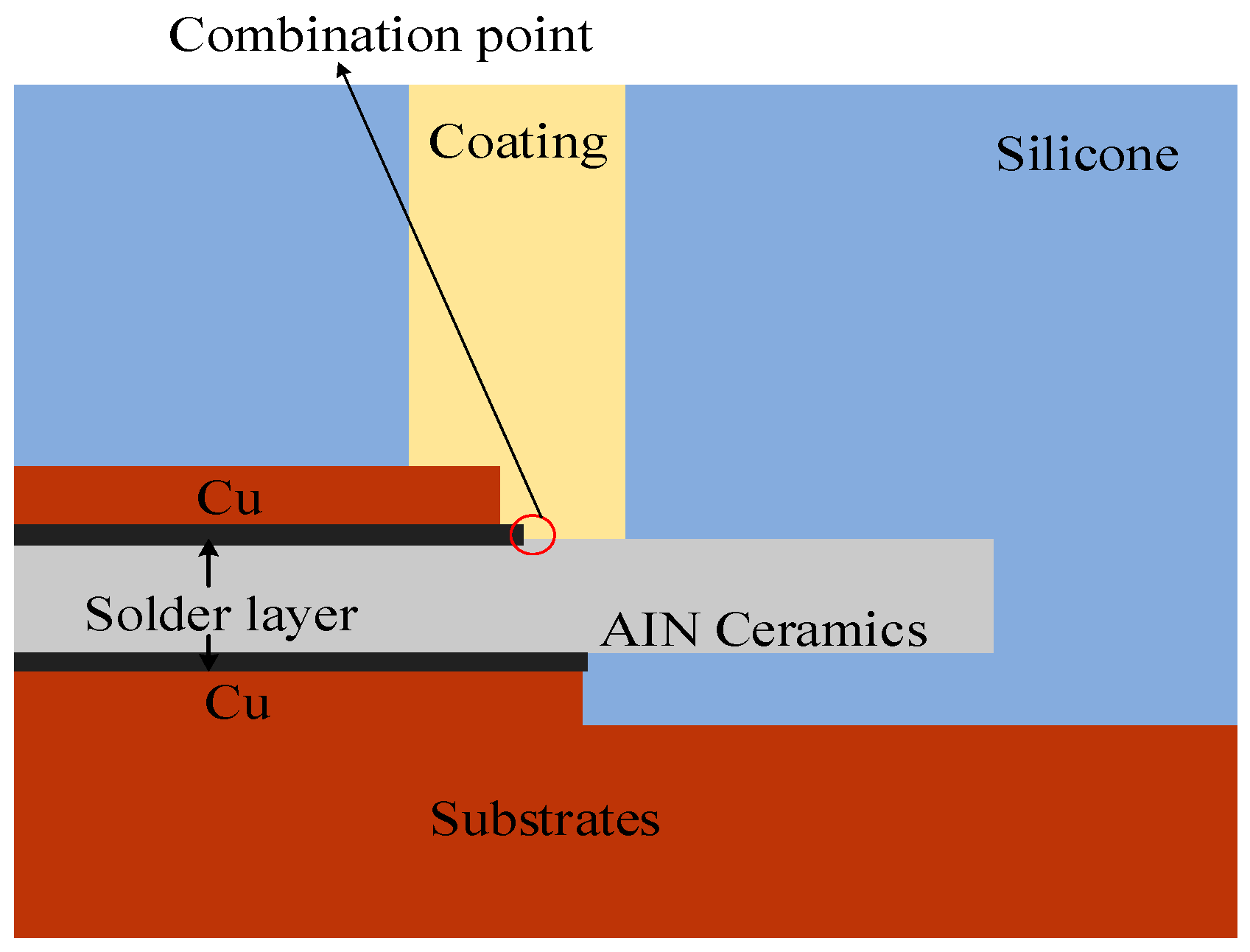
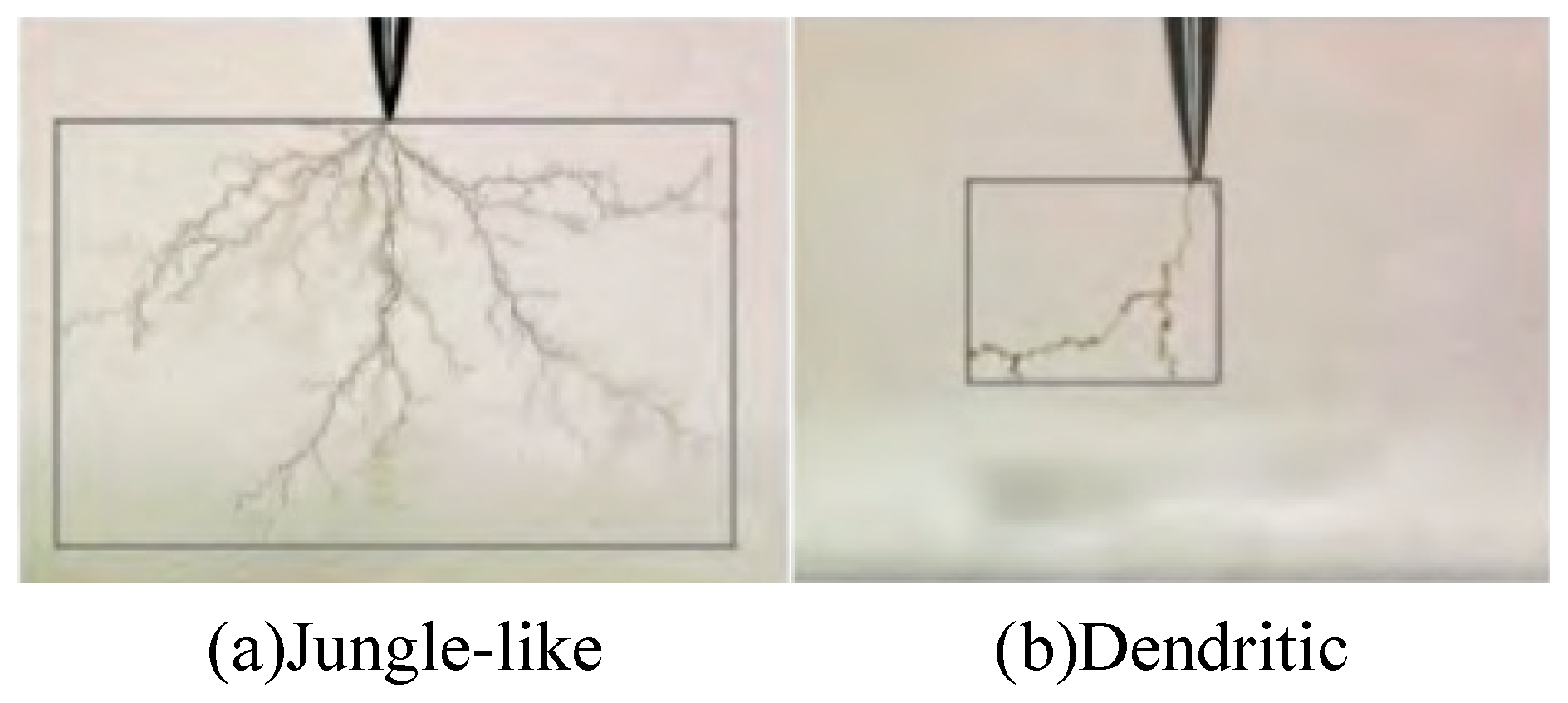

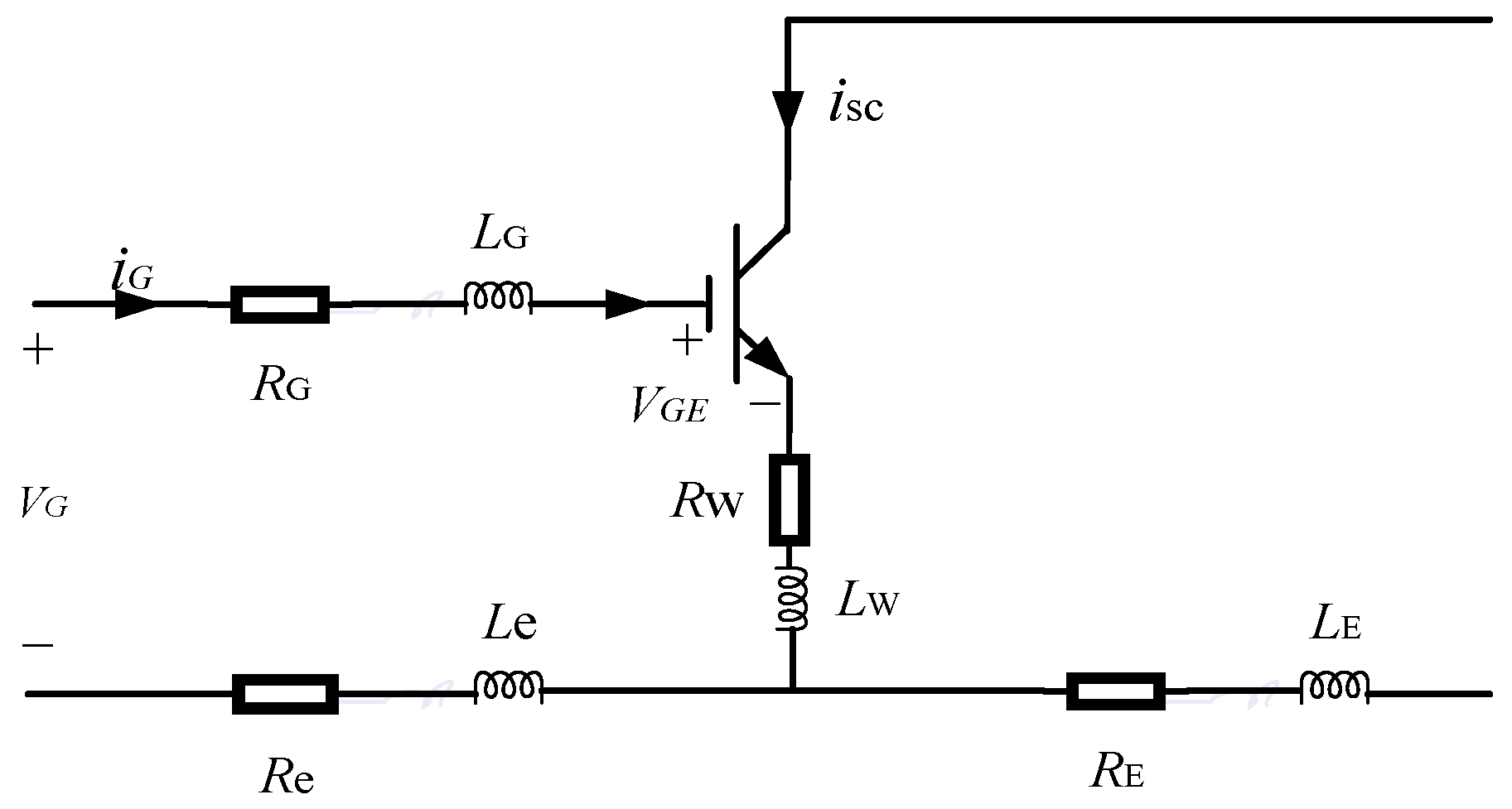

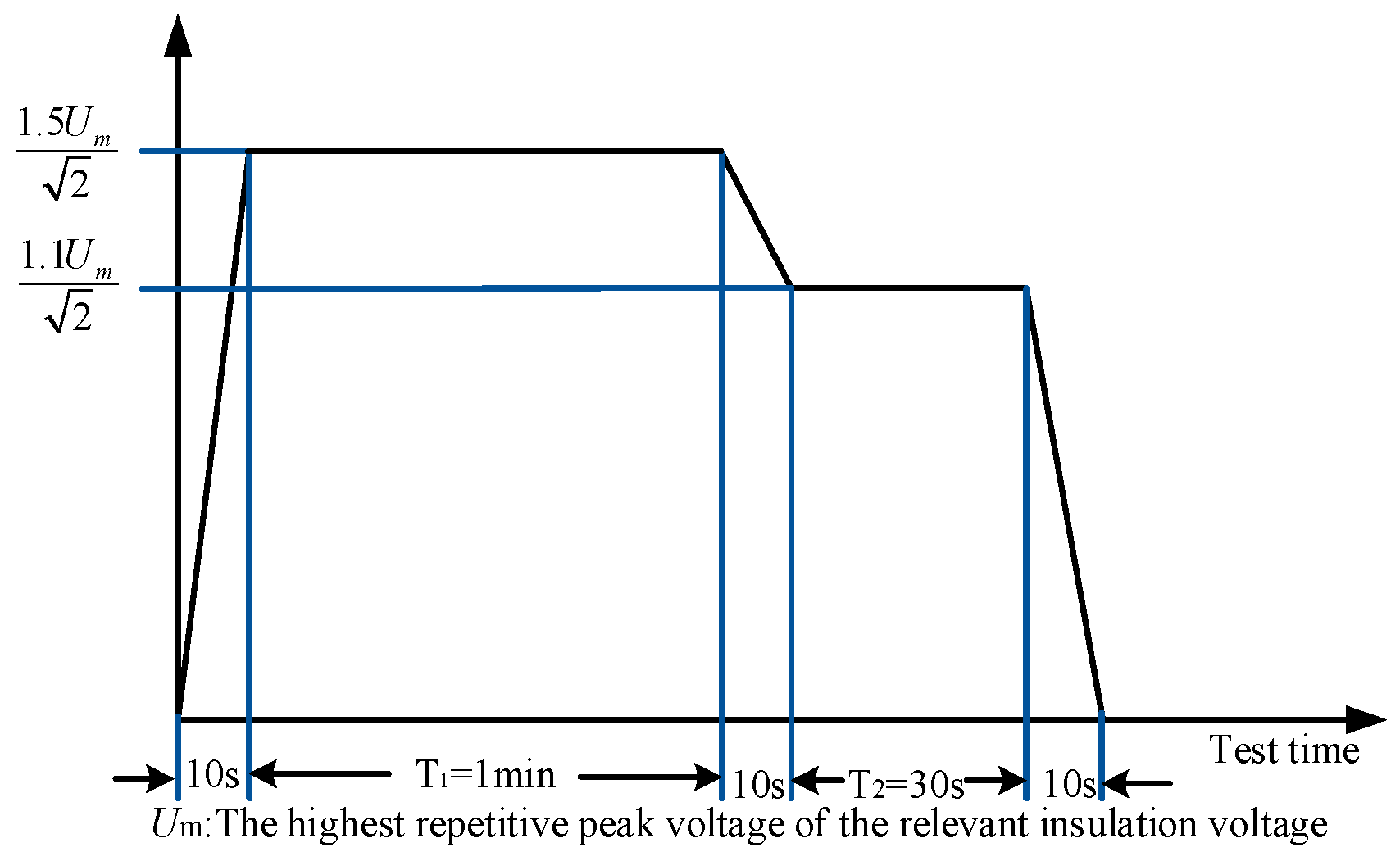

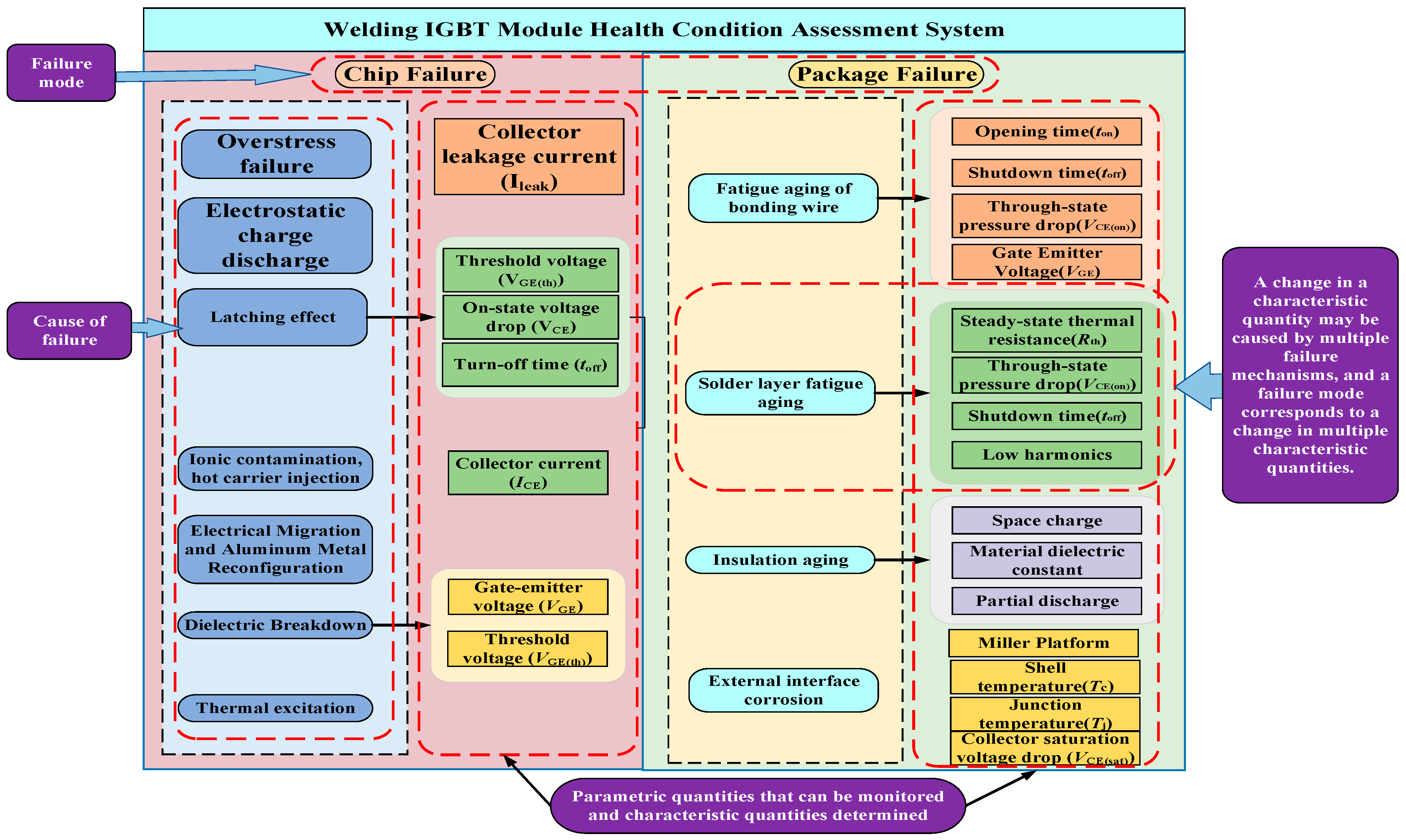
| Monitoring Objects and Means | Advantages | Disadvantages | |
|---|---|---|---|
| Junction temperature Monitoring | Infrared detection | Accurate test results | Disruptive encapsulation |
| Thermal sensor | Easy to implement | Small detection accuracy | |
| Model analysis | High precision | High requirements for model accuracy | |
| Steady-state electrical parameter | Good linearity of monitored parameters with temperature | Various thermal parameters affected by working conditions, affected by bonding wire breakage | |
| Transient electric parameter | Enables online monitoring No current injection required | The high requirement of obtaining parameters increases the cost. | |
| Parameter combination | Online monitoring is possible High monitoring accuracy | Thermal parameters are influenced by working conditions and bonding wire shedding | |
| Bonding wire shedding monitoring | Steady-state electrical parameter | Easy to measure | Need to correct the effect of junction temperature |
| Transient electrical parameters | Online monitoring is possible | High requirements for sensor accuracy | |
| Solder layer aging monitoring | Temperature parameters | Can be measured directly | Low accuracy and poor real-time performance |
| Thermal resistance parameters | Thermal network modeling | High model accuracy | |
Disclaimer/Publisher’s Note: The statements, opinions and data contained in all publications are solely those of the individual author(s) and contributor(s) and not of MDPI and/or the editor(s). MDPI and/or the editor(s) disclaim responsibility for any injury to people or property resulting from any ideas, methods, instructions or products referred to in the content. |
© 2023 by the authors. Licensee MDPI, Basel, Switzerland. This article is an open access article distributed under the terms and conditions of the Creative Commons Attribution (CC BY) license (https://creativecommons.org/licenses/by/4.0/).
Share and Cite
Kang, Y.; Dang, L.; Yang, L.; Wang, Z.; Meng, Y.; Li, S.; Sun, Y.; Wang, Y.; Dong, H. Research Progress in Failure Mechanism and Health State Evaluation Index System of Welded IGBT Power Modules. Electronics 2023, 12, 3248. https://doi.org/10.3390/electronics12153248
Kang Y, Dang L, Yang L, Wang Z, Meng Y, Li S, Sun Y, Wang Y, Dong H. Research Progress in Failure Mechanism and Health State Evaluation Index System of Welded IGBT Power Modules. Electronics. 2023; 12(15):3248. https://doi.org/10.3390/electronics12153248
Chicago/Turabian StyleKang, Yongqiang, Luzhi Dang, Lei Yang, Zhaoyun Wang, Yu Meng, Shuaibing Li, Yapeng Sun, Youyun Wang, and Haiying Dong. 2023. "Research Progress in Failure Mechanism and Health State Evaluation Index System of Welded IGBT Power Modules" Electronics 12, no. 15: 3248. https://doi.org/10.3390/electronics12153248







